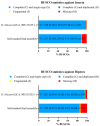De Novo Genome Assembly at Chromosome-Scale of Hermetia illucens (Diptera Stratiomyidae) via PacBio and Omni-C Proximity Ligation Technology
- PMID: 38392552
- PMCID: PMC10889594
- DOI: 10.3390/insects15020133
De Novo Genome Assembly at Chromosome-Scale of Hermetia illucens (Diptera Stratiomyidae) via PacBio and Omni-C Proximity Ligation Technology
Abstract
Hermetia illucens is a species of great interest for numerous industrial applications. A high-quality reference genome is already available for H. illucens. However, the worldwide maintenance of numerous captive populations of H. illucens, each with its own genotypic and phenotypic characteristics, made it of interest to perform a de novo genome assembly on one population of H. illucens to define a chromosome-scale genome assembly. By combining the PacBio and the Omni-C proximity ligation technologies, a new H. illucens chromosome-scale genome of 888.59 Mb, with a scaffold N50 value of 162.19 Mb, was assembled. The final chromosome-scale assembly obtained a BUSCO completeness of 89.1%. By exploiting the Omni-C proximity ligation technology, topologically associated domains and other topological features that play a key role in the regulation of gene expression were identified. Further, 65.62% of genomic sequences were masked as repeated sequences, and 32,516 genes were annotated using the MAKER pipeline. The H. illucens Lsp-2 genes that were annotated were further characterized, and the three-dimensional organization of the encoded proteins was predicted. A new chromosome-scale genome assembly of good quality for H. illucens was assembled, and the genomic annotation phase was initiated. The availability of this new chromosome-scale genome assembly enables the further characterization, both genotypically and phenotypically, of a species of interest for several biotechnological applications.
Keywords: Hermetia illucens; Larval serum protein-2; de novo genome assembly; gene annotation; topology associated domains.
Conflict of interest statement
The authors declare no conflicts of interest.
Figures









References
-
- Van Huis A., Van Itterbeeck J., Klunder H., Mertens E., Halloran A., Muir G., Vantomme P. Edible Insects: Future Prospects for Food and Feed Security (No. 171) Food and Agriculture Organization of the United Nations; Rome, Italy: 2013.
-
- Choi Y.C., Choi J.Y., Kim J.G., Kim M.S., Kim W.T., Park K.H., Bae S.W., Jeong G.S. Potential Usage of Food Waste as a Natural Fertilizer after Digestion by Hermetia illucens (Diptera: Stratiomyidae) Int. J. Indust. Entomol. 2009;19:4–171.
LinkOut - more resources
Full Text Sources
Miscellaneous

